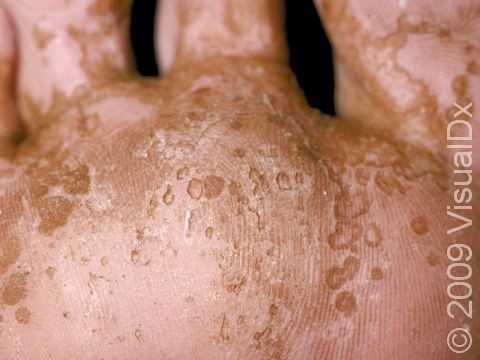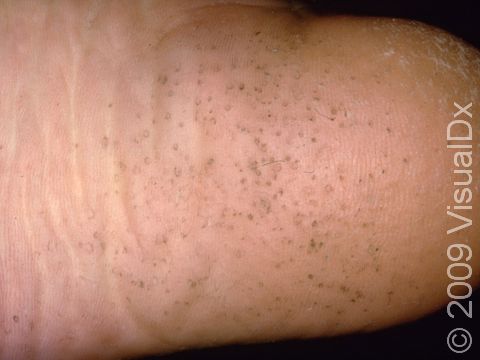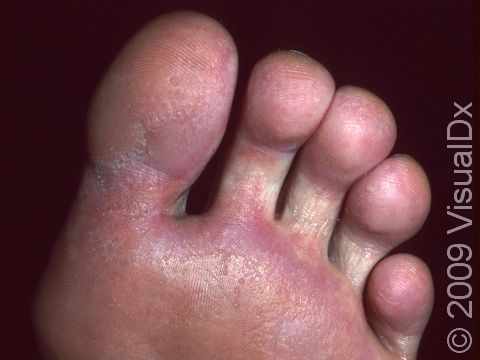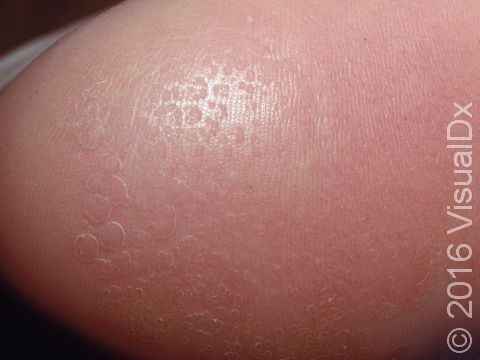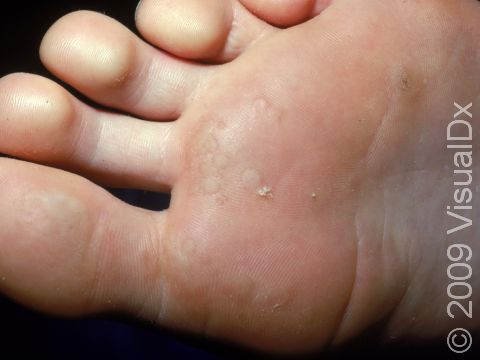Pitted Keratolysis
Pitted keratolysis is a skin condition affecting the soles of the feet and, occasionally, the palms of the hands. It is caused by a bacterial infection of the skin. Usually there is no pain, burning, or itch associated with the infection, but these symptoms may occur. Additionally, the affected areas may occasionally give off a foul odor.
Who's At Risk?
Pitted keratolysis can occur in people of any race / ethnicity, age, or sex, but it is more common in males. Athletes and military personnel tend to develop this condition most commonly. Conditions that make people more likely to develop pitted keratolysis include:
- Having sweaty feet.
- Hot or humid weather.
- Wearing unventilated (occlusive) footwear, such as rubber boots or vinyl shoes.
Signs & Symptoms
The most common locations for pitted keratolysis include:
- Pressure-bearing sites on the soles of the feet, especially the heels.
- Non-pressure-bearing sites on the soles of the feet.
- The palms of the hands.
In these areas, the condition appears as small (0.5-5 mm), shallow pits in the top layer of skin. These pits can sometimes form into larger, crater-like areas. There may be soft, wettish (macerated) white patches around the pits.
Pitted keratolysis is sometimes itchy or painful. The foot odor sometimes associated with pitted keratolysis may be socially embarrassing.
Self-Care Guidelines
Keeping the feet as dry as possible is important. Additionally:
- Wear absorbent cotton socks and change them frequently.
- Wash your feet with antibacterial soap (eg, Dial antibacterial bar soap) or antiseptic cleanser daily.
- Apply antiperspirant to the soles of your feet daily to minimize sweating (eg, with SweatBlock clinical strength antiperspirant wipes).
- Minimize the use of tight-fitting, occlusive footwear. (Try sandals if possible.)
- Avoid wearing the same pair of shoes multiple days in a row.
Treatments
Your medical professional may prescribe:
- A topical antibiotic such as erythromycin, clindamycin, mupirocin, fusidic acid, or benzoyl peroxide.
- Oral antibiotics such as erythromycin.
- Further measures to decrease moisture / sweating, such as a prescription antiperspirant containing aluminum chloride.
With some combination of these treatments, the skin lesions and odor of pitted keratolysis usually disappear within 4 weeks.
Visit Urgency
If attempts to minimize moisture do not improve the condition or if the affected areas are painful, itchy, or cause social embarrassment, such as from foul odor, make an appointment with a medical professional.
Trusted Links
References
Bolognia J, Schaffer JV, Cerroni L. Dermatology. 4th ed. Philadelphia, PA: Elsevier; 2018.
James WD, Elston D, Treat JR, Rosenbach MA. Andrew’s Diseases of the Skin. 13th ed. Philadelphia, PA: Elsevier; 2019.
Kang S, Amagai M, Bruckner AL, et al. Fitzpatrick’s Dermatology. 9th ed. New York, NY: McGraw-Hill Education; 2019.
Last modified on June 17th, 2024 at 3:46 pm

Not sure what to look for?
Try our new Rash and Skin Condition Finder
